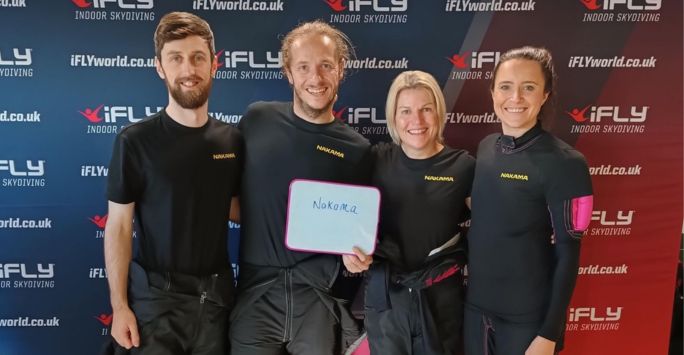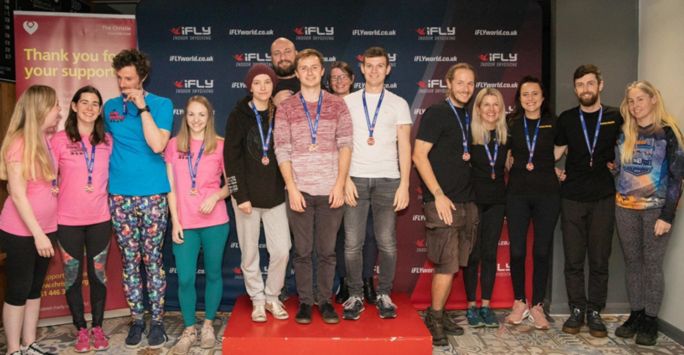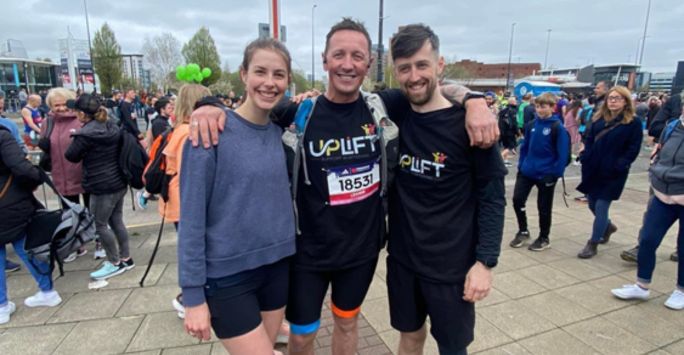
In early November, Student Doctor Eoin Black was feeling the excitement as he took part in the British Indoor Skydiving Nationals held at iFly in Manchester. Competing with Team Nakama, they achieved third place overall.
Along with this achievement, Eoin has used his passion for skydiving to raise money for various charities and is able to bring some of the broader aspects of skydiving to his medical degree. Eoin shares more on the competition day, his charity work and his next skydiving challenge.
“Last weekend I competed with Team Nakama at the British Indoor Skydiving National 4-way FS Single A category and took third place overall. This was my first time competing in this competition which was the first year the competition has been held in the north of England.
“We're a new team having only formed a month ago but quickly learned the ropes under the expert coaching of Kate Lindsley, who is a physiotherapist by day and multiple British and World Cup and championship skydiving medallist.”

Competition winners with their well-earned medals
The British Indoor Skydiving Nationals is a national competition that is organised by the British Indoor Skydiving Association and is held at one of the four competition wind tunnels in the UK. There were seven competitions that ran side by side this year the competition I was part of consisted of 10 rounds, each lasting 35 seconds, in which teams must complete as many predetermined formations as possible while being watched by a judging panel. Each completed formation equals one point and the team with the most points wins.
“For my team, this was our first indoor competition, and we were incredibly pleased to have come third overall particularly given the experience and skill level of some of the other teams that took part.”
I started outdoor skydiving when I was 17 and during the first few months of learning, I was making mistakes frequently and often without knowing what I was doing wrong or how to fix it. A training jump as a student consists of 45 seconds in which to practise or develop a new skill, demonstrate your competency in that skill and do so while managing the natural stress, fear, and anxiety that comes with being in freefall.
“What drew me initially to indoor skydiving was the need to practise and develop skills in a more controlled and simulated environment. Little did I realise that it was as fun and diverse a sport as outdoor skydiving and that is what made me stay to do more.”
Indoor skydiving has a diverse appeal, offering the sensation of freefall in a controlled and safe environment. The sport has a broader popularity and accessibility than outdoor skydiving, mainly because it doesn’t involve jumping from an airplane, there are fewer restrictions on who can participate, and the cost is considerably less than traditional outdoor skydiving, though still not cheap.
“For me personally, the most fun parts of the sport are the sensation of flying, the sense of achievement when you learn a new skill and the social aspects to the sport.”
It is physically and mentally challenging and the best way to learn is through constructive feedback from a coach. For me, learning from what has gone wrong and how to improve, taking criticism, and reflecting can be challenging especially when you are under pressure to perform at your best. No one likes being told what they have done wrong but sometimes it is the best way to learn.
Skydiving also presents one of the most unique ways to get involved in charity work and there are plenty of opportunities to do so. Last year I was approached by the testicular cancer charity Oddballs to film one of their university representatives doing their first tandem skydive.
Our team coach, Kate, started a mental health charity recently called Uplift and many of us have been keen to lend a hand. In April, we ran the Liverpool half marathon and Manchester Marathon to raise money for them and they were the official charity partner of the university skydiving team. In October, I became a peer mentor with the charity and was invited to attend a training day hosted by the Samaritans focused on conversations with vulnerable adults, which had a great crossover with the teaching I received in CCP during my earlier years at medical school.

“While the skills developed in skydiving do not directly align with the technical aspects of medicine, the broader attributes of composure under pressure, teamwork, situational awareness, risk assessment, adaptability, and attention to detail are qualities that have a massive crossover between skydiving and medicine.”
Additionally, the culture of safety that is ingrained in skydiving has helped me to develop a safety-conscious mindset that can be applied to medical practice.
For my next skydiving challenge, I have just joined an 8-way formation skydiving team with the aim of competing at the British Outdoor Nationals next year. I think the biggest challenge with this is that it is a new style of competition for me, with a whole new set of formations and rules to learn. We will be training over winter in the wind tunnel in France until the weather gets more consistent in the spring and then we will be training outdoors throughout summer until September.”